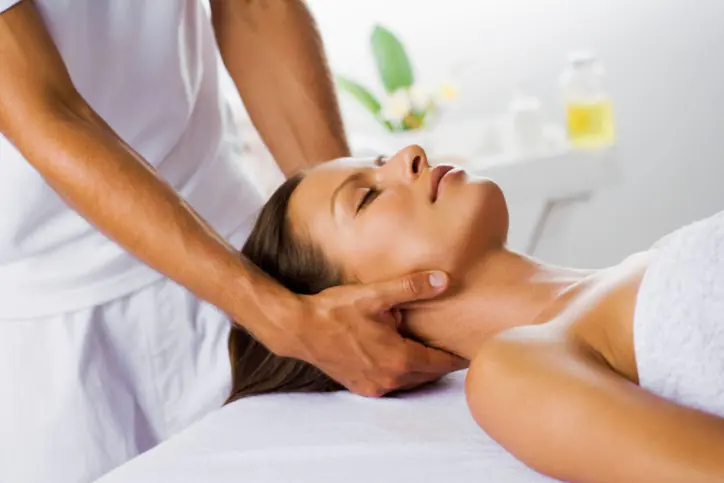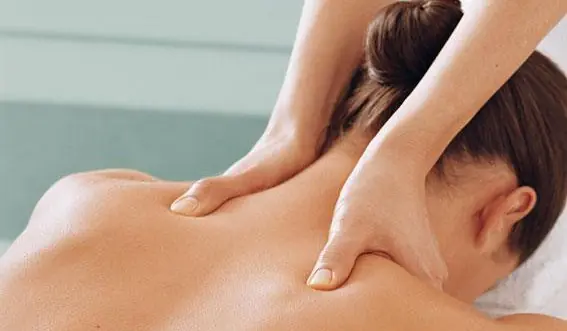Massage of the cervical collar area is necessary for people leading a sedentary lifestyle. By the way, with age, absolutely everyone needs it, regardless of work and lifestyle. It is recommended as an excellent preventive remedy for headaches and pain in the cervical spine. If you carefully familiarize yourself with the techniques and techniques, you can perform the procedure at home.
Many experts claim that if you start massaging your neck and shoulders at the age of 26, the skin will become firmer, more elastic, and will not succumb to the signs of aging. In this case, pain will also not bother you. If you constantly feel sharp and nagging pain in this area, do not get carried away with self-medication, but immediately seek help from specialists.
Massage of the front and side of the neck
The main movement used to massage the anterior part is stroking along the sternocleidomastoid muscle. The lateral part is massaged along the inner edge where the jugular vein passes. Through these vessels, blood flows from the head, neck, pharynx, and larynx into the superior vena cava.
Thanks to the movements performed by the specialist, the outflow of blood through the veins and lymph through the lymphatic vessels increases. As a result, a change in blood pressure occurs, which leads to tissue renewal, improved nutrition of the cavity and larynx.
Stroking. The patient should take a sitting position. The neck is exposed to the chest. The specialist becomes in a position that is comfortable for him and begins to perform light strokes from the lower jaw to the collarbones.
Both hands should be involved in stroking. Then the massage therapist wraps his hands around the neck so that the thumbs are next to each other and the rest are under the ears. The palms begin to smoothly move down to the collarbones, the arms should be tucked towards the armpits and shoulders. Having finished moving in this area, the specialist moves his hands under the lower jaw and continues moving in the same direction. You can perform alternating stroking, where one hand strokes and the other holds the head.
As for kneading, it is performed only on the sternocleidomastoid muscle. Kneading is done with one or two hands, thumb or all fingers. The rubbing is done very gently and smoothly, as there are quite a lot of large blood vessels and nerves in this area. If the area is massaged with the thumb, the movements in this case are rougher and more intense than with the other fingers.
Massaging the side parts is carried out alternately: the movement is performed with one hand, and the patient’s head is supported with the other hand. In this area, short circular movements are performed, starting in the submandibular region and smoothly moving around the entire cervical region of the larynx. If the patient has dense lymph glands, in this case the area around the glands is rubbed first, and only then the glands.
Vibration and shaking are performed to treat inflammation in the pharynx and dry throat. To do this, place one hand under the lower jaw and hold the head with the other. Light shaking movements are performed. To make the massaged area more relaxed, the patient can tilt his head to the side where the shaking is performed.
For special diseases, laryngeal tremors are performed. In this case, the specialist clasps the larynx with his thumb on one side and the rest on the other, slowly moving down and forward, performing trembling movements. These movements affect not only the larynx, but also the windpipe. It is good to carry out the procedure for inflammation of the bronchial tubes.
For more serious diseases, such as vocal cord paralysis, vibration is performed in the upper and lower laryngeal nerves. When the superior laryngeal nerve vibrates, place your fingers under the hyoid bone and perform a quick shake. In some cases, a painful sensation is felt where the fingers are applied. Vibration of the inferior laryngeal nerve is performed between the windpipe and the sternocleidomastoid muscle.

The skin will become more elastic, pain will disappear
Back massage
It is performed in the area of the trapezius muscle and the muscles that support the cervical region. Often, massage of this particular area is performed in most cases. The patient's head should be in a straight position, movements are performed from bottom to top, to the sides.
First, kneading is done. In this case, the trapezius muscle rises slightly and rolls between the fingers. Rubbing is performed on both sides, or separately, depending on the specifics of the technique being performed. In the neck area the rubbing is more intense. As a rule, thumbs are used, less often four fingers folded together.
For greater efficiency and enhanced reception, sawing is performed with both hands. In this case, you need to ensure that the skin moves with the hand. Chopping this area is performed in the same specifics as a back massage (chopping technique).
Trembling of the cervical nerves is carried out as follows: hold the patient’s head with one hand, and grasp the trapezius muscle with the other hand so that the thumb is on one side and the rest on the other. In this position, trembling movements are performed. The shaking is performed throughout the entire area, stopping separately in the area of each cervical vertebra.
After completing all the necessary techniques, slow movements of the head are performed: forward, backward, flexion, extension, circling the head.

In some cases, elements of acupressure are used
How to massage the neck for osteochondrosis
If you have osteochondrosis, you can massage your neck yourself, but to get the most maximum and professional result, you need to use a comprehensive massage of the collar area. If you perform the techniques correctly, you will immediately feel an improvement. Therapeutic massage is best performed before bed.
The patient should assume a sitting position so that the back and body are in a straight position. The first session should last no more than 15 minutes. With subsequent techniques, the execution time increases. As a rule, 3-5 minutes are allotted for one exercise. For greater effectiveness, massage oil is used.
- The first step is to massage the back of the neck. To do this, place your fingers on the line where hair growth ends. Smooth, gentle strokes are performed from top to bottom. At first the movements are barely noticeable, but the intensity of the techniques gradually increases.
- Next, straighten the palm and begin stroking in the same way, but with the side of the palm, alternately changing the sides of the palm.
- We place our fingers in the back of the head and perform circular movements from top to bottom. First we massage the area from ear to ear, then from top to back.
- Gently pinch the skin on the sides of the spine line between your fingers and begin to carefully palpate it. We finish with a light stroking.
- Let's move on to the front of the neck. We start with light stroking from top to bottom.
- After light stroking, circular rubbing is performed over the entire surface of the neck, excluding the area of the veins and carotid artery.
- The procedure should be completed with light stroking.
Massage for cervical osteochondrosis can be strengthened by massaging the shoulders. At home, all movements are performed using a similar method: stroking, rubbing, kneading, circular movements, palpating. I would like to note that in the bottom case, acupressure is included. In this case, pain points are found and rubbed with the necessary intensity.



